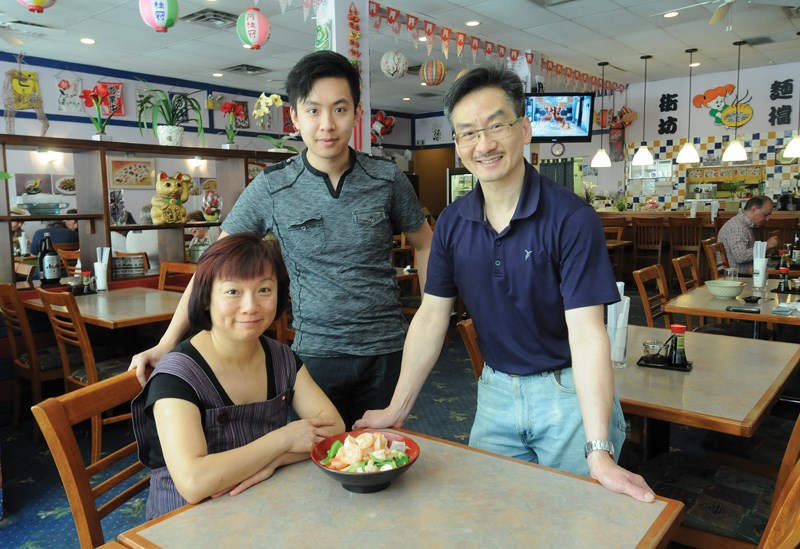Her dad looked like Cruella De Vil.
That’s what Sereen Hon thought when she was in preschool. She didn’t think he was a threat to Dalmatians, but she’d been told her father had salt and pepper hair and the only comparison she could think of was Cruella’s black and white mane.
Telling the story 17 years later as the lunch rush moves in and out of the Neighbourhood Noodle House, Sereen laughs. Her family – including her father, Simon, and mother, Janet – join her.
But under the surface there’s a hard truth: she didn’t know what her father looked like.
That’s because Simon’s typical day involved working in the kitchen until about 3 a.m. and rolling out of bed at 9:30 a.m. to buy the next day’s food.
“We lost time with the family,” Janet says.
Janet came to Canada from Guangzhou, China, in 1986. With a limited grasp of English (“just A B C D.”) and $100 in her pocket, she got jobs at two Chinatown restaurants including a Pender Street eatery where her future husband was working in the kitchen.
Entering their early 30s, Simon and Janet were married, had two children (both of whom are now university students) and opened their own restaurant: the Neighbourhood Noodle House, offering Chinese, Japanese and Vietnamese food.
The formula worked, but it came with a cost.
Holidays were spent in the restaurant. When Janet needed surgery, she did paperwork in the hospital.
“In 20 years, we almost never have the day off,” Janet says wistfully.
But after two decades their plan is to serve their last meal on Aug. 28.
Asked about her retirement plans, Janet smiles.
“Rest. And then do some travelling.”
Closing the restaurant is both a business decision and a personal one. But amid the myriad of factors leading to the shutdown of the Noodle House is a lack of help.
Finding workers has been a problem, and over the past four years it’s gotten worse, Janet explains. Immigrants seem wealthier and less willing to work for minimum wage.
Janet says she’s not sure if the North Shore’s high cost of living is a factor.
Asked where she lives, Janet replies: “North Burnaby.”
99 per cent of life is just showing up
About three kilometres and one big hill away, the Tomahawk Barbecue is an hour from closing time. It’s 3 p.m.
Chuck Chamberlain greets customers on the way out, making sure their Yukon bacon and Klondike toast was to their liking. It’s what he’s been doing since the Beatles broke up and the first Trudeau was prime minister.
But in nearly half a century, Chamberlain says he’s never had problems filling a job. Grill cooks start at between $18 and $20 an hour, and – given the restaurant’s been operating since 1926 – job security is not bad.

His workers usually stay for years, but over the last few months one of his workers got another job. Another retired. A third suffered a stroke.
Chamberlain talked to four workers who all seemed interested. But when he finalized a time for them to start, not one showed up.
“I realized we really have major problems,” he says.
Maintaining the status quo would’ve meant big change, Chamberlain says, explaining he would’ve been back at the grill while handing out double shifts to everyone else.
The restaurant could’ve functioned, but the level of quality would’ve dropped.
“I had visions of the customers going out and saying, ‘Boy, that place has gone downhill.’”
The choice between cutting hours and cutting quality was no choice at all, Chamberlain explains.
The Tomahawk now closes at 4 p.m. Monday to Thursday.
Chamberlain thinks he made the right choice, but his bottom line is still going to take a hit, he says.
Chamberlain knows the cost of living is high on the North Shore. “But the cost of living is high everywhere.”
He knows some of his colleagues look to the government, but then again: “It’s always easy to blame the government.”
Chamberlain suspects he’s feeling the effects of subtle shifts in the industry.
There are kitchens where staff are like Ikea customers: they assemble food, they don’t really cook it.
Cooking on a flattop is a skill, Chamberlain explains.
“Very few people are able to do it. And not many people are going into this profession long-term to make a career out of it.”
Broken links in the food chain
“When things like the Tomahawk … when they start cutting back on hours, that tells you how serious it is.”
Restaurants around B.C. are reeling, notes B.C. Restaurant and Food Services Association president Ian Tostenson.
The food chain was in good shape back in 2010 but things changed when then- Employment Minister Jason Kenney made changes to the temporary foreign worker program.
“That had some really devastating consequences for kitchens,” Tostenson says. “Everywhere’s got a shortage of workers, and in particular, cooks and chefs.”
To ensure Canadians had first crack at all jobs, the previous Conservative government capped the number of foreign workers employers could hire at 10 per cent.
Chamberlain’s dilemma is illustrative of the bigger problem, because even when employers are willing to pay, employees aren’t necessarily willing to take their money.
By the time a lot of cooks hit their late 40s they’re ready to hang up the apron, Tostenson explains.
“That’s one problem,” he says. “To compound it, we’re not getting enough people into the industry.”
While there are measures that can be taken, Tostenson is realistic about the breadth of baby boomers walking out of the job market and the dearth of young people walking in.
“Demographics are not on our side whatsoever,” he says.
Help! I need somebody
About 28 per cent of West Vancouver residents are 65 or older. The percentage of residents between 25 and 35 is less than six.
“It’s a struggle for businesses who need employees to work in the early morning or later into the evenings,” says Ambleside and Dundarave Business Improvement Association executive director Stephanie Jones.
From her first day with the BIA, Jones has been addressing the labour shortage.
Her task is made herculean by housing prices (often exceeding $3 million for a single family home), vacancy rates (about 0.2 per cent) and population trends (down about 2,000 in the last six years).
“We want to see West Vancouver growing and thriving,” she says. “For that, we need to be able to attract a diverse population.”
That means people with a diversity of ages and ethnicities, as well as income levels, Jones says.
In the meantime, some shops are adjusting hours based on the availability (or lack thereof) of employees.
With the next municipal election about 15 months away, Jones says she’s keeping a close eye on West Vancouver council for meaningful conversation about how the labour shortage can be assuaged.
“We will be having (that conversation) with all councillors and the community as we head into an election.”
But while political gridlock may shoulder some blame, Jones also notes literal gridlock.
Economic drivers
“You just can’t get as much done as you used to,” Eric Miura notes.
Miura, the owner of property maintenance company Miura Property Services, estimates he’s taken a 15 per cent hit to his bottom line in recent years.
While his dozen employees idle in daily traffic jams near bridgeheads, Miura is paying them overtime.
“When you’re stuck on Highway 1 for an hour regularly, multiplied by 12 staff members, that adds up pretty quickly,” he says. “Company efficiency … has taken a tremendous hit.”
According to 2015 data, the number of workers coming over the bridges was up 14 per cent over a 10-year period.
The bottlenecks have become a gauntlet employees need to overcome on their way onto the North Shore, and especially on their way out.
It’s made it harder to keep workers.
“There’s a lot of growth and construction and jobs out in the valley. I don’t blame them for wanting to be employed closer to their residence,” he says.
TransLink has floated some innovative transit solutions, including van pools with major employers like Seaspan.
However, there’s still a long way to go to address the North Shore’s “transportation deficit,” according to Miura.
“In Europe and Asia, infrastructure is usually ahead of development. North America runs on a reactionary improvement model.”
At its worst, the still-hot housing market functions like an Ayn Rand fever dream where lower income people are left on the other side of the moat.
“We cannot be a community of businessmen and doctors and lawyers alone,” Miura says.
Questions and …
What we’re seeing is a global problem up close, according to Capilano University school of business professor Daniel Yasinski.
But while the problem is everywhere, the cost of living makes the issue acute on the North Shore.
“Entry level workers can’t afford to live on the North Shore unless they’re living at home. That’s a major problem,” he says.
In a 2016 Vancity survey, 32 per cent of renters were either “slightly” confident or not confident at all they’d be in the same apartment six months from now.
While there’s an “entrepreneurial spirit” in many young students eager to open their own businesses: “They’re not going to be opening up construction companies and they’re not going to be opening up restaurants because they realize how difficult that task is,” says Yasinski.
There are opportunities for young managers who can analyze huge blocks of data (“The world will always need bean counters,” he explains) but the management opportunities once offered by major department stores like The Bay and Eaton’s are largely a thing of the past.
There’s also a marked decline in the mom and pop shop, he says.
Back at the Neighbourhood Noodle House, Sereen and her brother Sunny are both unequivocal: they might work in the restaurant business at some point, but they have no interest in owning a restaurant.
Yasinski talks about a wide range of factors at work in the conundrums faced by local restaurants: from the role of government to the way the food industry is non-existent in most post-secondary schools, and the snobbery that sometimes pushes young people from blue to white collar careers.
Coming up with solutions for such a wide-ranging problem remains a great challenge.
“I think it’s just a matter of,” Yasinski says before stopping himself. “I don’t know what the answer is.”



